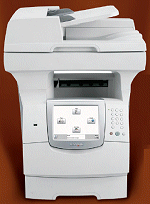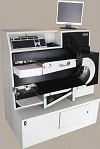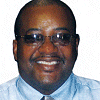Document Management :: It Prints! It Faxes! It Scans!
##AUTHORSPLIT##<--->
And it even gathers data and scores tests.A state-of-the-art multifunction publishing systemcombines the work of several devices into asingle unit, creating dramatic savings in paper useand personnel time.
 In printing, scanning, copying, and publishing, the new buzzword is combo: combination systems that take the strengths of several pieces of hardware—and sometimes software—and combine them into one. Advances in these technologies can save districts money by cutting the use of staff time, paper, and accessories such as print cartridges. Also, these powerful, multifunction devices can make tabulatingand evaluating students’ test results easier.
In printing, scanning, copying, and publishing, the new buzzword is combo: combination systems that take the strengths of several pieces of hardware—and sometimes software—and combine them into one. Advances in these technologies can save districts money by cutting the use of staff time, paper, and accessories such as print cartridges. Also, these powerful, multifunction devices can make tabulatingand evaluating students’ test results easier.
A primary concern for many K-12 school districts considering new printers, scanners, and fax machines is the cost of materials over time—especially paper. For example, Cypress-Fairbanks Independent School District in Houston looked hard at the cost of paper in its student-assessment testing process, which generated large quantities of printed material and required costly preprinted forms. Through a new publishing system, from Lexmark, the district has slashed paper costs and has been able to reassign one full-time staffer who did little other than scan in paperwork. Cypress-Fairbanks is using the new system to handle the district’s formative assessment tests, some of which are given to portions of the district’s 90,000 students as often as every six weeks.
The system includes both software and hardware for accessing the student information database, selecting students to be tested, and printing pre-labeled test sheets with a student identifier on each. After the test is completed, the same Lexmark printer/scanner/copier device—a Lexmark model X646dte—is used to scan the test sheets back in, read the results, create reports for teachers, and then send the data to the district’s central database for storage and further analysis.
According to Director of Information Services Margaret Reed, the district will break even on the cost of the new system in two years. Cypress-Fairbanks, growing at a rate of 3,000 to 3,500 students a year, spent $28,000 for the software and about $4,000 for each of the 30 multifunction devices it’s running throughout the district, Reed says.
Labor and paper savings can be tabulated fairly easily, but one cost metric that is typically difficult to calculate is the amount a district saves by having more-accurate data. With the previous system at Cypress-Fairbanks, completed tests were scanned in twice, first by teachers who needed immediate results for grading, then again at the district level for the back-end database and for state reporting. Results sometimes differed, depending on the scan program’s tolerance for erasures and other idiosyncrasies. With 21 regular secondary schools and regular assessment tests, the district “needed to come up with a distributive way of printing and scoring to transfer the data electronically,” Reed explains. The secondary- school testing program was targeted initially because “the sheer volume [of paperwork] got our attention.” The Lexmark system will be expanded eventually to the district’s 45 elementary schools, which can also benefit, although they don’t test with the same frequency.
The system runs on two servers at a central facility, then communicates to the multifunction devices on the campuses. A panel on the front of each device leads teachers through selecting the correct test and printing it, and then scanning papers in afterward.
The devices can also be used as fax machines or copiers, and can e-mail as well, a function that has come in handy, Reed says, for scanning and then e-mailing items such as attendance lists. This takes the place of having to copy such items multiple times and physically distribute them.
Before selecting a vendor, Reed says, the district issued a request for proposals and considered several other solutions that could do similar things but weren’t as integrated as the Lexmark system. An important feature for Cypress-Fairbanks was the ability to integrate with the district’s existing back-end system, a SunGard Pentamation system for administrative and performance analysis, that connects to an IBM Informix database server. Other solutions, Reed says, tended to include built-in databases and student assessment pieces, which the district already had.
A Hard Look at TCO
According to Kathy Thomas, manager of education strategy at Dell, total cost of ownership issues are receiving more scrutiny. That means districts are eyeing not just the initial cost of a device, but the expense of maintaining it over time. In relation to printers, TCO costs can include replacement toner cartridges and print cartridges, along with the cost of new fusers for laser printers, and service expenses after product warranty expiration. These costs can far exceed the original purchase price of the equipment, Thomas says. Realizing that, schools are “looking for better total cost of ownership,” she says. “They’ve done a lot more calculations on their own, and they’re saying, ‘We want to look at [issues including] service, the fuser, the toner cartridge, and a longer warranty.’”
That explains the popularity of combination systems, which produce savings on the initial purchase price by combining functions, as well as incur lower TCO costs. They can also decrease the cost of total pages printed over time, since it costs less initially to purchase one device instead of two or three. Cost-perpage calculations should be supplied with any printer; if not, schools considering a purchase can ask the manufacturer for that information.
Another Way to SAVE

DIGITAL SCANNERS YIELD GREAT REDUCTIONS IN PAPER USE—OR ELIMINATE IT ALTOGETHER.
One big way that districts can save money is through the use of digital scanners, which reduce paper costs in two ways: One, they can eliminate the need for expensive, custom preprinted forms, since they can be programmed to print their own forms; and two, paper often needn’t be used at all—scanners can move information digitally through the system without printing it out.
There are three kinds of scanner technologies for collecting data from forms: the familiar optical character recognition (OCR), intelligent character recognition (ICR), and, especially useful for test-reading, optical mark recognition (OMR).
The latter technology, OMR, is the simplest. OMR scanners simply detect whether a mark has been made in a preprogrammed spot, but not its shape. OMR scanners can be fast—up to 15,000 forms an hour on Pearson Assessments’ new Insight 150 system, for example—and if you’re looking for a testreading system, they can be an excellent answer. OMR scanners use precise algorithms to decide how dark a mark must be to register a read. According to a Pearson document on different scanning technologies,“ICR, OCR and OMR: A Comparison of Technologies,”OMR is the fastest and most accurate of data-collection technologies.
ICR recognizes handprinted characters, such as those written on a handheld device. It isn’t perfect and requires manual editing after a handwritten document is scanned, but it can reduce the time needed to type in a document.
OCR turns printed characters into digital information, and has been used for years to translate printed material into digital documents. It’s more accurate than ICR, since it is reading printed characters, and can be extremely useful for quickly digitizing forms or test materials.
In a further bid to save money, Thomas says, some districts are moving toward more centralized printing, in which larger printers, or multifunction printers, are added to the network in a central location. That can help keep a lid on having to increase the number of devices throughout the district. Having fewer devices, in turn, can lower long-term service and maintenance costs.
Thomas says it’s now rare for a district to purchase a standalone scanner, for example. “Combos make sense in so many ways,” she says. “[Sales of] scanners by themselves have dropped off dramatically.”
Streamlining With Software
Sophisticated new software products can reduce the time staff members spend scanning test results, managing paper, or even handling administrative chores. School District 5 of Lexington and Richland Counties, one of the largest districts in South Carolina, has made significant reductions in both paper use and staff time—and anticipates more savings ahead—by using an electronic imaging and publishing system that includes electronic document scanning and automatic storage technologies.

James Gibbs of School District 5 of Lexington-RichlandCounties projects that his district’s new publishing systemwill produce a 50 percent drop in paper consumption,and savings in staff time that reach 60 to 70 percent.
That’s according to James Gibbs, information systems resource specialist with the district, which encompasses 12 elementary schools, four middle schools, three high schools, and one alternative school. Gibbs says that for six months the district has been using software products from AIG Technology that include Doc e Serve, Doc e Scan, and Doc e Fill. The software has been used in selected areas, and based on results so far, the plan is to gradually roll out the system elsewhere.
For example, Gibbs says, Doc e Fill allows a district employee who needs to make a change to a federal W-4 tax form to access a secure personal area where forms are stored, pull up his or her individual form prepopulated with information, make changes, then route the form appropriately, all by responding to guidance from the software. The process concludes, without any paper issued, when an e-mail informs the user that the changes have been made and recorded. At any time during the process, the employee can check on the progress of the change.
The conversion from a paper-based process to an electronic one, Gibbs says, virtually eliminates errors, since there’s no need to retype information from paper forms. The scanning solution also does away with the need to buy numerous expensive preprinted forms.
Another component of AIG’s publishing system, Doc e Scan, can be used to manually scan a document into an imaging system for filing and archiving. Instead of storing a paper form filled out by hand, staff members can scan in and store documents electronically. Doc e Serve, the third product employed by Lexington- Richland, is used for capturing print documents from the district’s legacy systems. For example, Gibbs says, the payroll department can use the system to avoid printing unneeded paper documents. Doc e Serve essentially intercepts print jobs issued by the back-end legacy system, sends them to scan instead, then files them electronically, saving paper, time, and money.
Since the system has been in use only half a year, Gibbs says, it’s too soon to say what costs savings it will produce. However, he projects that paper consumption will drop by at least 50 percent eventually, and savings in staff time may eventually reach 60 to 70 percent.
Scanning Goes Local
Scanners can be a great way to save time, but only if they’re distributed and used efficiently and effectively. Fort Worth Independent School District in Texas used to spend 40 to 50 hours scanning in completed test-paper sheets, says William Whitfield, coordinator of data and technical resources for the 80,000-student district. “What we’ve started doing recently is having schools scan in most of their [tests] at their sites,” Whitfield says, “and then upload the data files to us.”
By training teachers and staff at the local level how to scan and thenupload data files to the central office, Fort Worth Independent SchoolDistrict has reduced the time it takes district staff to scan 40,000 to50,000 tests from more than 40 hours to less than 10 hours.
The school sites, which are using smaller scanners in the field and a large central scanner in the main office, both from Pearson Assessments, have reduced the time it takes Whitfield’s staff to scan 40,000 to 50,000 tests from more than 40 hours to less than 10 hours.
Pearson offers a range of data-collection solutions for K-12 for assessment, testing, survey, and data management. The large central scanner is a Pearson NCS 5000i that is capable, Whitfield says, of scanning up to 5,000 documents an hour. That’s if everything is working perfectly, however. Seemingly minor glitches such as a torn answer sheet, candy residue on a test sheet, or erasure marks can stop the scan and must be rectified before the process can continue. High-volume scanners including the 5000i tie images to optical mark recognition (OMR) data records, creating files that can be archived and retrieved later for review or evaluation. Student work such as essays can be routed to teachers or to other reviewers for evaluation.
Individual schools within Fort Worth ISD already had the smaller scanners, which are OMR-only (see “Another Way to Save,” page 30 of our magazine). Also, the district has been saving significant time since it decided to train teachers and staff at the local level how to scan and then upload data files to the central office. “We’re now spending much, much less time,” Whitfield says. “Schools were able to take ownership of this, and the [scanned] documents are cleaner and better.”
The new procedure saves time, Whitfield says, because school personnel no longer must drive to the central office to physically deliver paper surveys and answer documents for scanning. Also, he and his staff used to have to call someone at an individual school if something was amiss on an answer sheet. That added more time to the process; now teachers can address those issues themselves as they scan the documents in locally.
Another advantage of scanner systems like the one in use at Fort Worth is that they allow student ID and Social Security numbers to be preprinted on forms, which reduces errors and saves data-entry time. Once the central office has the test data, it can combine scores from each school, run them through a scoring program, and produce electronic reports. In the Fort Worth system, those reports are then sent back to the schools for individual use in addressing issues and improving instruction.
Savings That Add Up
According to one publishing system vendor, a typical school uses an average of 2,500 to 3,500 total pages of paper annually per student in copying and printing. Multiply those numbers by your typical per-page cost for paper alone, and the benefits of better overall document management can be dramatic. Careful choices in printers, scanners, copiers, and the software to manage it all can produce surprising savings in materials costs and staff efficiency.
:: web extra :: For more on this topic, visit T.H.E. Journal. In the Browse by Topic menu, click on Hardware/Software.
Linda L. Briggs is a freelance writer based in San Diego, CA.